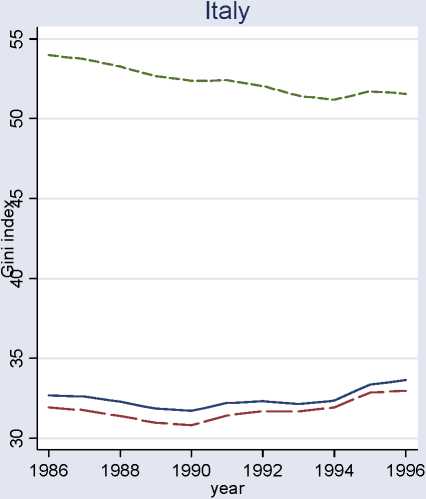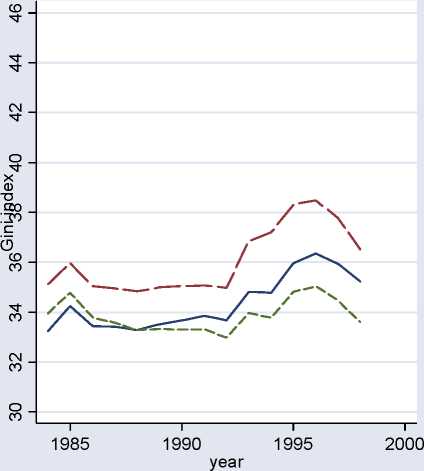We also consider the role of physical and human capital. As can be seen in figure 7, these
variables have very significant impact on income inequality. Looking at the left panel, where Italian
inequality has been recalculated using US values for capital per worker and average years of education in
the population, we notice that inequality would have been much higher if we were to consider the highly
educated US labour force instead of the low educated Italian population. According to the estimated
model in table 6, educational attainment has two countervailing effects: on the one hand, the increased
supply of human capital reduces the wage differential; on the other, by making skilled labour cheaper, it
also induces substitution between skilled and unskilled, thus depressing the labour share. The overall
effect is therefore ambiguous, and can only by judged case by case. In the case of Germany, a country
with similar educational attainment to the US, it is physical capital that generates distributional differences.
The high German capital-labour ratio had a strong equalising effect, through its impact on both wage
inequality and the labour share.
Figure 7 — Counterfactual 5: Italy and Germany inequalities with US human and physical capital
Counterfactual with US physical and human capital

predicted--wth US capi
Germany

predicted--wth US capi
----wth US education
----wth US education
In order to provide some information about the order of magnitude of these impacts, table 7
reports estimates of the reduced form equation for income inequality corresponding to equation (23). The
table reports the OLS standardised beta coefficients, which are to be read as the change, in terms of a
fraction of a standard deviation in the dependent variable, induced by a standard deviation change in the
26
More intriguing information
1. The voluntary welfare associations in Germany: An overview2. Globalization, Divergence and Stagnation
3. The name is absent
4. Inflation and Inflation Uncertainty in the Euro Area
5. The name is absent
6. El impacto espacial de las economías de aglomeración y su efecto sobre la estructura urbana.El caso de la industria en Barcelona, 1986-1996
7. Biologically inspired distributed machine cognition: a new formal approach to hyperparallel computation
8. Evidence-Based Professional Development of Science Teachers in Two Countries
9. Are class size differences related to pupils’ educational progress and classroom processes? Findings from the Institute of Education Class Size Study of children aged 5-7 Years
10. The name is absent